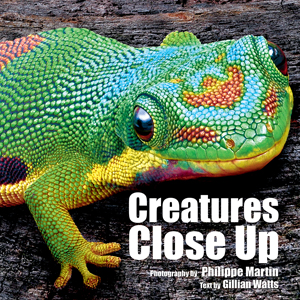| ________________
CM . . .
. Volume XXIII Number 16. . . .December 23, 2016
excerpt:
A young computer savvy generation is discovering many ways to use their technical knowledge. Some are also captivated by the thrill of “extreme” activities. Combine these with an interest in photography, and it may open up a whole new frontier for them. Creatures Close Up will introduce readers not only to the possibilities of macrophotography but also to some unusual creatures found around the globe. The introduction gives a simple explanation of how digital cameras work before examining a special process developed by nature photographer Philippe Martin. After taking multiple super-close up photos of his subject, he uses computer software that brings the perfectly focussed parts of each shot into one composite picture. Called focus-stacking, it results in spectacular images that allow us to see brilliant colours, exquisite patterns and textures, the finest details—individual hairs on the legs of a beetle, or the colour variation on each quill of a tenrec (Madagascar hedgehog) that we would otherwise miss. The images in this 64-page book include many creatures: insects, spiders, invertebrates, reptiles, mammals and birds. Brief descriptive captions with each photo offer fascinating information, e.g. we can see a wolf spider’s “two very large eyes about four smaller ones” and observe how the female carries newly hatched baby spiders on her abdomen. The photos include a small portion of background to help the reader understand the animals’ habitats. The photo technique invites repeat viewing of these wonders of nature revealed: the more you look at the mossy leaf-tailed gecko, for instance, the more you notice the texture of its skin, the variety of colour and how the shape of its feet show perfect adaptation to its environment. The frog from Madagascar on the following page has such amazing camouflage it is tricky to separate it from the swampy vegetation it sits on. It is easy to see how much skill and patience it took to find and capture these species on film and then to enhance them through the use of computer technology. An index is included. Creatures Close Up is a book to enjoy on several levels: simply as a feast for the eyes, appreciating the wonders of nature, considering the photographic possibilities for oneself, learning new facts about unusual species, and stirring the imagination about nature’s adaptations. It will appeal to all ages. Highly Recommended. Gillian Richardson is a freelance writer living in BC.
To comment
on this title or this review, send mail to cm@umanitoba.ca.
Copyright © the Manitoba Library Association. Reproduction for personal
use is permitted only if this copyright notice is maintained. Any
other reproduction is prohibited without permission.
Next Review | Table of Contents For This Issue - December 23, 2016 |
